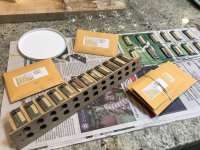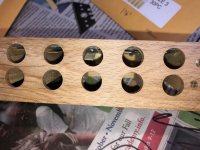AlicePalace
Member
Now that we’re having some rainy, fall weather, I’m finally getting around to replacing the leathers on the ”repair-practice” beater accordion that I grabbed for $20 a few months ago. I have removed all of the reeds from the higher of the two bass blocks (because I will also be practicing waxing them back on), removed the old wax, removed most of the old leathers (I left the ones that aren’t curled or coming off), and have carefully cut (guillotined with a razor) and glued the replacement leathers.
I‘ve just started placing the reeds back in the block, and I notice that there are some new leathers that are already so badly curled they’re completely unacceptable. What the …?? Is it because the leather is too thin for the length (the one in the pic is ~28mm)? I bought a set of 7 sizes and cut to the same length as the old leathers, using the closest size in the set regardless of the thickness of the leather — generally used sizes 5, 6 and 7 because those were the closest lengths, but the leather is much thinner than the original. Should I instead have been trying to match both length and thickness? Width is also a bit different in many cases. Should I have been cutting to the same width as well? Or perhaps do I need to put glue further down the length of the leather? I estimate I put the glue about 6-7mm down the length.
I don’t want to wax these in until I understand how to make this right. Thank you!
I‘ve just started placing the reeds back in the block, and I notice that there are some new leathers that are already so badly curled they’re completely unacceptable. What the …?? Is it because the leather is too thin for the length (the one in the pic is ~28mm)? I bought a set of 7 sizes and cut to the same length as the old leathers, using the closest size in the set regardless of the thickness of the leather — generally used sizes 5, 6 and 7 because those were the closest lengths, but the leather is much thinner than the original. Should I instead have been trying to match both length and thickness? Width is also a bit different in many cases. Should I have been cutting to the same width as well? Or perhaps do I need to put glue further down the length of the leather? I estimate I put the glue about 6-7mm down the length.
I don’t want to wax these in until I understand how to make this right. Thank you!



